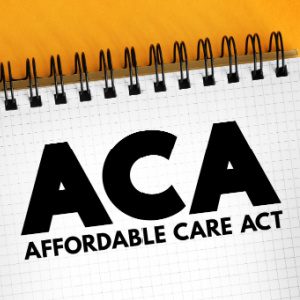
The IRS announced on July 25 that the health plan affordability threshold under the Affordable Care Act will be 9.12% in 2023, down from 9.61% in 2022.
The adjusted percentage applies on a plan-year basis, not a calendar-year basis, and affects an employer’s potential liability for ACA shared-responsibility penalties. Non-calendar-year plans will continue using 9.61% in 2023 until their new plan year starts.
Safe-Harbor Income Calculations
Most employers cannot know the total household income of each employee, so the IRS created three alternative safe-harbor methods of calculating total household income for purposes of the premium affordability threshold:
1. Federal Poverty Line (FPL) Safe Harbor
Most employers use the federal poverty line (FPL) safe harbor method for calculating employee household income for purposes of ACA affordability.
Under this method, the highest premium allowed for an employer’s lowest-cost plan in 2023 will be $103.28 monthly for self-only coverage. This is based on the look-back 2022 FPL of $13,590 in annual income.
The rate for 2023 represents a slight increase from 2022 when the top premium was $103.15.
2. Rate of Pay Safe Harbor
This alternative calculation method involves two employer tests: the hourly rate for full-time employees and the annual salaries of full-time employees.
Companies that don’t meet FPL safe harbor guidelines often turn to this method because it uses both the lowest hourly pay rate and the lowest monthly salary for an employee group.
For example, if the lowest-paid hourly employee earns $15/hour, under the Rate of Pay safe harbor method premiums for the lowest-cost, self-only coverage cannot exceed $177.84/month.
If the lowest-paid full-time salaried employee earns $36,000/year, premiums for the lowest-cost, self-only coverage cannot exceed $273.60/month.
3. W-2 Wages Safe Harbor
In the W-2 Wages alternative, employers use the number in Box 1 on an employee’s W-2 form. This is not very predictive, however, since the numbers aren’t available until January of the plan year. Not surprisingly, this safe harbor method is used the least often.
Cost of Non-Compliance
If your company provides a Minimum Essential Coverage (MEC) plan but does not meet premium affordability threshold requirements, you can be penalized $2,750 per employee for the plan year.
If the coverage offered fails to provide MEC or meet affordability requirements, the penalty increases to $4,120 per employee for the plan year.
For More Information
For more information, refer to IRS Rev. Proc. 2022-34 or consult with your qualified benefits counsel.